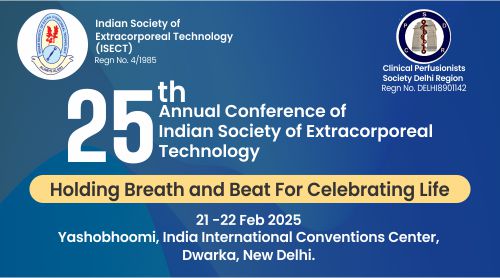About ISECT
History of Perfusion in India
A skilled perfusionist is one of the biggest assets to his team because he is responsible for maintaining the functioning of all the vital organs of the patient when the surgeon goes about the task of repairing cardiac defects. The conduct of perfusion has important implications not only in terms of early survival, but also on the entire hospital course and long-term outcomes.
The origin and progress of open heart surgery and perfusion technology in India started between 1948 and 1960.The practice of cardiothoracic surgery was evolving in India, and there were no dedicated programs for imparting training to Perfusionist. Only few selected centers in India used to practice cardiac surgery, and these were centered in Mumbai and Vellore. These two centers played a pivotal role in the further progress of the specialty as well as in training the budding surgeons and perfusionists throughout the country.
Cardiovascular perfusion was then performed by a variety of persons with varying qualifications and experience. During the initial period of the history of cardiac surgery in India the assistant surgeon used to run the pump. This was then taken over by theater assistants, who had been assisting the “perfusionist” surgeon in setting up the extensive heart-lung machine system comprised of the reusable disc oxygenator, stainless steel discs, end plates, connectors and other components that had to be thoroughly cleaned and sterilized before and after use.
Early days of Perfusion technology at AIIMS in 1968 was performed with a helix oxygenator and a Pemco heart-lung machine. The combination of helix oxygenator and the Pemco heart-lung machine was very ideal to work with. The heart-lung machine was completely manual and reliable. However, assembling the circuit along with the helix oxygenator was time consuming. With the invention of the disc oxygenator, the performance was better and hence the team switched over to the disc oxygenator with silica gel coating. The glass chamber made it possible to ensure all was fine but the major problem was that the glass chamber was fragile, to prepare the circuit required a lot of labor, one had to wash it, then coat the discs with silica gel then pack it in a safe manner, and finally get it sterilized. The tubing had to be washed, and then the inner part was cleaned with a pull through (a rod with a cloth bunch at one end). In 1976, with the development of the bubble oxygenator and the heart-lung machine with safety limits and alarm capabilities, perfusion techniques became quicker and safer. Bubble oxygenators had the risk of air embolism and required huge priming volumes. This led to the introduction of the membrane oxygenator in 1989, which required less priming volume as well and had an arterial filter to eliminate the risk of air embolism. However, until 1999- 2000, membrane oxygenators were used electively for longer anticipated cardiopulmonary bypass (CPB) times.
Perfusion education in India
The efforts to provide scientific education and training in perfusion technology were initially made by the Christian Medical College (CMC), Vellore in the early 1980s by diploma course in perfusion technology. Later on in1986, the same was extended to King Edwards Memorial Hospital at Mumbai. In 1990, the Indian Association of Thoracic and Cardiovascular Surgeons in coordination with Medtronic, started a one-year course which included an initial six months of training in basic medical sciences theory and six months practical training in perfusion at any reputed institute.
The two year post graduate diploma in clinical perfusion course was introduced at Nizams institute of medical sciences(NIMS), Hyderabad in 1992 for the first time in the country. Curriculum was designed by our senior members Mr. N. Chandra Sekhar and Mr. K. Madhusdanrao and both of them were given position in the institute as tutors in the rank of assistant professors at that institute later it was followed by many institutions in the country.
Perfusion education in India has come a long way from the initial phase when there were no formal training programs, only on-the-job training. Now there are a multitude of courses like Bachelor's degree, Master's degree, Post Graduate Diploma etc. Our Perfusionists are well versed in all aspects of Extra-Corporeal Technology and have the expertise to handle Perfusion for a variety of procedures for both congenital and acquired conditions in the neonatal, infant, pediatric and adult population.
Perfusion practices and challenges of perfusion in India
A perfusionist in India is faced with many practical problems while conducting a clinical perfusion. The cost effectiveness and availability of hardware is an important issue. The limited availability of modern monitoring facilities which are hard to find in many institutes such as online hematocrit and arterial blood gases monitoring, NIRS, etc. introduces the need to be extra vigilant and makes the conduct of perfusion difficult. In some institutes the anesthesiologist controls the decision-making on the use of various drugs and anesthesia gases and a constant dialogue between the two is essential. Moreover undue stress and overwork has the potential to limit the efficiency of patient management. In many centers, the surgeons and anesthesiologists exercise strict control over the whole team leaving no important role for the perfusionist in prime decision-making.


